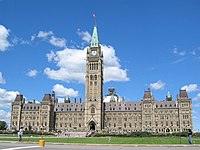
Photo from wikipedia
Post-earthquake cordons have been used after seismic events around the world. However, there is limited understanding of cordons and how contextual information such as geography, sociocultural characteristics, economy, and institutional… Click to show full abstract
Post-earthquake cordons have been used after seismic events around the world. However, there is limited understanding of cordons and how contextual information such as geography, sociocultural characteristics, economy, and institutional and governance structures affects decisions and operational procedures, including aspects related to spatial and temporal attributes of cordon establishment. This research aims to fill the gap in cordon knowledge through a qualitative comparative case study of two cities: Christchurch, New Zealand (Mw 6.2 earthquake, February 2011) and L’Aquila, Italy (Mw 6.3 earthquake, 2009). Both cities suffered comprehensive damage to their city centers and had cordons established for extended periods of time. Data collection was done through purposive and snowball sampling whereby 23 key informants were interviewed in total. Research participants held expert knowledge in their roles and responsibilities, that is, council members, emergency managers, politicians, business/insurance representatives, academics, and police. Results illustrate that cordons were primarily established to ensure safety of people and to maintain security. The extent and duration of the cordons were affected by the recovery approaches taken in respective cities, that is, in Christchurch demolition was widely undertaken which supported recovery and allowed for faster removal of cordons. In contrast, authorities in L’Aquila placed high value on heritage buildings which led to recovery strategy based on preserving and restoring most of the buildings which extended the duration of cordon. Extended cordons have many similarities but evolve overtime. This evolution of cordons is affected by site-specific needs; thus, cordons should be understood and planned based on contextual realities.
Journal Title: Earthquake Spectra
Year Published: 2022
Link to full text (if available)
Share on Social Media: Sign Up to like & get
recommendations!